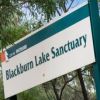Early History
In the early days before the lake was formed, Kooyongkoot Creek
wound its way down the valley from Mitcham to Blackburn on its way to the Yarra River. It would have been joined along the
way, particularly in winter, by many little rivulets and streams; some of these gullies can still be seen as you walk around
the lake today. In summer, the creek is suspected to have dried up at times.
Lake Surrounds
The lake was dammed in 1889 initially to provide
water for local fruit growers, but was later used and misused for various reasons and activities until the late 1970s. Today,
activities on the lake are limited to protect the surrounding environment. The lake is fed by a number of small creeks to
its east and many small surrounding gullies. The dam wall is located in lake's west reaches, Lake Road runs along the top
of this wall. Kooyongkoot Creek heads west from the wall, through the beginnings of its course to the Yarra River.
It was
initially about 50 feet (15 m) deep where the creek had been mined for antimony, but recent studies show that it is not that
deep today, having silted up over the intervening years. In the 1920s, diving towers were erected and swimming lessons were
held at the lake, the water quality was as yet unaffected by surrounding land clearing, agriculture and development. The Blackburn
Swimming Club was forced to close in 1931 due to vandalism of the facilities.
A Rubbish Dump
During the 1950s and 1960s, the lake became
a dumping ground for rubbish, and there are supposed to be old car bodies and other rubbish at the bottom. These would have
leached acids, lead and hydrocarbons into the water over the years. Pollution in the lake renders it unusable as a source
of water for the surrounding human population or agriculture. In 1962 the dam wall in Lake Rd was built by the MMBW to form
a retarding basin to prevent flooding further down Kooyongkoot Creek, and the Lake Rd Bridge was demolished in 1965.
Bridges
The bridges that cross the lake and its creeks and gullies include:
- Friends
Bridge (early 1900s, rebuilt 1981)
- Billabong Bridge (built 1980s)
- Lake
Road Bridge (built 1888, demolished 1965, rebuilt 2002)
Recreation
Throughout the park's history, much of the recreation in the park revolved around the lake, however today recreation
revolves around the appreciation of the Australian native flora, much of which has been regenerated over time. The park is
popular with bushwalkers. Cycling is also popular but is usually only partaken locally as the park does not host a cycling
through-route trail.

